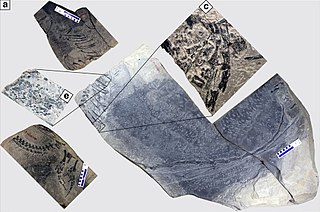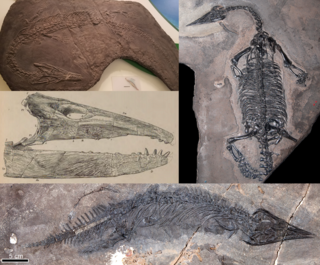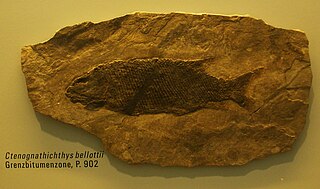
Dinocephalosaurus is a genus of long necked, aquatic protorosaur that inhabited the Triassic seas of China. The genus contains the type and only known species, D. orientalis, which was named by Li in 2003. Unlike other long-necked protorosaurs, Dinocephalosaurus convergently evolved a long neck not through elongation of individual neck vertebrae, but through the addition of neck vertebrae that each had a moderate length. As indicated by phylogenetic analyses, it belonged in a separate lineage that also included at least its closest relative Pectodens, which was named the Dinocephalosauridae in 2021. Like tanystropheids, however, Dinocephalosaurus probably used its long neck to hunt, utilizing the fang-like teeth of its jaws to ensnare prey; proposals that it employed suction feeding have not been universally accepted. It was probably a marine animal by necessity, as suggested by the poorly-ossified and paddle-like limbs which would have prevented it from going ashore.

Lukousaurus is an archosauromorph based on most of a small skull's snout, displaying distinctive lachrymal horns, found in the Early Jurassic-age Lower Lufeng Formation, Yunnan, China and was described by Chung Chien Young in 1940. The generic name refers to the Lugou Bridge, lit. “crossroads”, near Beijing, where the Sino-Japanese War started. L. yini is tentatively classified as a theropod dinosaur by some allied to ceratosaurs, by others a coelurosaur. Its skull is rather robust for its size though the teeth were described by the author as typically theropodan. Whatever Lukousaurus was, it was definitely an archosauromorph.

Shansisuchus is an extinct genus of archosauriform reptile belonging to the family Erythrosuchidae that lived during the Middle Triassic in what is now China. The first fossils of Shansisuchus were discovered from the Ermaying Formation of Shansi Province in 1964 by Chinese paleontologist Yang Zhongjian. Like other erythrosuchids, Shansisuchus was a large-bodied carnivore with a large, deep skull. Shansisuchus is unique among early archosauriforms in having a hole in its skull called a subnarial fenestra.

Thalattosauria is an extinct order of prehistoric marine reptiles that lived in the middle to late Triassic period. Thalattosaurs were diverse in size and shape, and are divided into two superfamilies: Askeptosauroidea and Thalattosauroidea. Askeptosauroids were endemic to the Tethys Ocean, their fossils have been found in Europe and China, and they were likely semiaquatic fish eaters with straight snouts and decent terrestrial abilities. Thalattosauroids were more specialized for aquatic life and most had unusual downturned snouts and crushing dentition. Thalattosauroids lived along the coasts of both Panthalassa and the Tethys Ocean, and were most diverse in China and western North America. The largest species of thalattosaurs grew to over 4 meters (13 feet) in length, including a long, flattened tail utilized in underwater propulsion. Although thalattosaurs bore a superficial resemblance to lizards, their exact relationships are unresolved. They are widely accepted as diapsids, but experts have variously placed them on the reptile family tree among Lepidosauromorpha, Archosauromorpha, ichthyosaurs, and/or other marine reptiles.
Paleontology or palaeontology is the study of prehistoric life forms on Earth through the examination of plant and animal fossils. This includes the study of body fossils, tracks (ichnites), burrows, cast-off parts, fossilised feces (coprolites), palynomorphs and chemical residues. Because humans have encountered fossils for millennia, paleontology has a long history both before and after becoming formalized as a science. This article records significant discoveries and events related to paleontology that occurred or were published in the year 2007.
Eomamenchisaurus is a genus of mamenchisaurid sauropod dinosaur from the Middle Jurassic Zhanghe Formation of Yuanmou, Yunnan, China. The type species is E. yuanmouensis, described by Lü Junchang et al. in 2008.

Ctenognathichthys is an extinct genus of prehistoric bony fish that lived during the Anisian and Ladinian ages of the Middle Triassic epoch in what is now southern/southeastern Switzerland and northern Italy.

Coptoclavidae is an extinct family of aquatic beetles in the suborder Adephaga. The Coptoclavidae lived from the Late Triassic to the Early Cretaceous. Coptoclavidae is a member of the adephagan clade Dytiscoidea, which contains other aquatic beetles. Suggested reasons for their extinction to include the rise of teleost fish, or competition with Gyrinidae and Dytiscidae, which possess defensive secretions and sucking channels in the mandibles of larvae, which coptoclavids likely lacked. It has been suggested that the genus Timarchopsis and the subfamily Timarchopsinae are only distantly related to other coptoclavids based on cladistic analysis, with Timarchopsis being more closely related to geadephagans like carabids and trachypachids instead. Another study also suggested similarly for Coptoclavisca and possibly other coptoclaviscines.
The Xinlong Formation is an Early Cretaceous geologic formation in Guangxi, southern China.
Paleontology or palaeontology is the study of prehistoric life forms on Earth through the examination of plant and animal fossils. This includes the study of body fossils, tracks (ichnites), burrows, cast-off parts, fossilised feces (coprolites), palynomorphs and chemical residues. Because humans have encountered fossils for millennia, paleontology has a long history both before and after becoming formalized as a science. This article records significant discoveries and events related to paleontology that occurred or were published in the year 2010.
The Haifanggou Formation, also known as the Jiulongshan Formation, is a fossil-bearing rock deposit located near Daohugou village of Ningcheng County, in Inner Mongolia, northeastern China.

Anshunsaurus is a genus of thalattosaurs within the family Askeptosauridae. Fossils have been found from Middle Triassic deposits in Guizhou, China. Three species are known: the type species A. huangguoshuensis, the slightly older species A. wushaensis, and the species A. huangnihensis.
Jianchangopterus is a genus of scaphognathine rhamphorhynchid pterosaur from the Middle Jurassic of western Liaoning, China. Jianchangopterus is known from a nearly complete skeleton with skull preserved. It was collected from the Tiaojishan Formation. It was first named by Lü Junchang and Bo Xue in 2011 and the type species is Jianchangopterus zhaoianus.

Hanosaurus is an extinct genus of marine reptiles that existed during the Triassic period in what is now China. The type species is Hanosaurus hupehensis. It was a small animal, with specimens measuring 79.4 cm (31.3 in) long in total body length, which likely fed on soft-bodied prey.
This list of fossil arthropods described in 2010 is a list of new taxa of trilobites, fossil insects, crustaceans, arachnids and other fossil arthropods of every kind that have been described during the year 2010. The list only includes taxa at the level of genus or species.

Laosuchus is an extinct genus of chroniosuchian known from the Permian-Triassic boundary of Asia. Two species have been named.
The Xiaowa Formation is a Carnian-age geological formation found in southern China. It is a sequence of limestone and marls from the Carnian stage of the Triassic. Its lower section was previously known as the Wayao Formation or Wayao Member of the Falang Formation. In 2002, the Wayao Member was renamed and raised to the Xiaowa Formation to prevent confusion with an Eocene unit of the same name. Crinoids and marine reptiles are abundant in the Xiaowa Formation, forming a lagerstätte known as the Guanling biota. Ammonoids and conodonts found in the formation constrain its age to the early Carnian. Reptiles of the Guanling biota include ichthyosaurs, thalattosaurs, placodonts, and Odontochelys. Sedimentary events within this formation have been tied to the Carnian Pluvial Event.
Luopterus is an extinct genus of anurognathid pterosaur containing only the holotype species L. mutoudengensis that is known from the Middle Jurassic Tiaojishan Formation of Qinglong, northern Hebei Province, China. It was originally named as a species of Dendrorhynchoides in 2012 but it was moved to the genus Luopterus in 2020. Luopterus was originally thought to be from the Early Cretaceous, with a wingspan that is about 40 centimeters (16 in), making it one of the smallest known pterosaurs.
Grabauornis is an extinct genus of enantiornitheans from the Early Cretaceous of China.

Dinocephalosauridae is an extinct clade of marine and terrestrial archosauromorph reptiles that lived throughout the Triassic period. Like tanystropheids, they are characterized by their long necks, lengthened by either addition of cervical vertebrae or elongation of the individual bones.
















